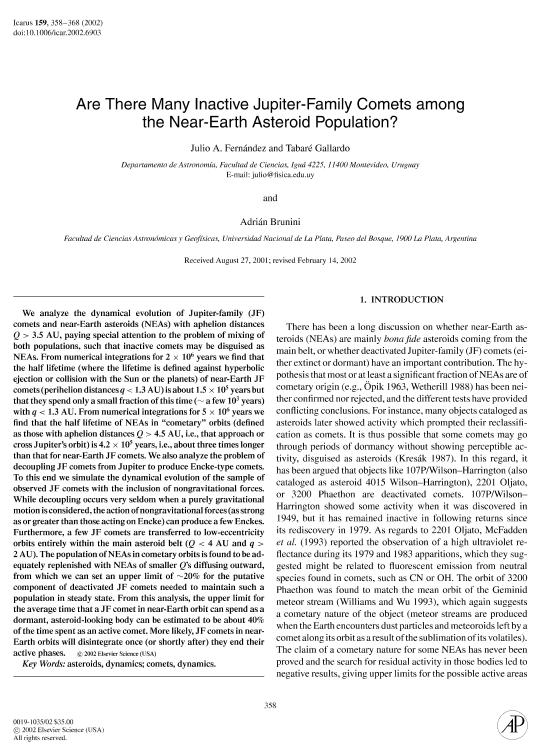Artículo
Are there many inactive Jupiter-family comets among the near-earth asteroid population?
Fecha de publicación:
10/2002
Editorial:
Academic Press Inc Elsevier Science
Revista:
Icarus
ISSN:
0019-1035
Idioma:
Inglés
Tipo de recurso:
Artículo publicado
Clasificación temática:
Resumen
We analyze the dynamical evolution of Jupiter-family (JF) comets and near-Earth asteroids (NEAs) with aphelion distances Q > 3.5 AU, paying special attention to the problem of mixing of both populations, such that inactive comets may be disguised as NEAs. From numerical integrations for 2 × 106 years we find that the half lifetime (where the lifetime is defined against hyperbolic ejection or collision with the Sun or the planets) of near-Earth JF comets (perihelion distances q < 1.3 AU) is about 1.5 × 105 years but that they spend only a small fraction of this time (∼ a few 103 years) with q < 1.3 AU. From numerical integrations for 5 × 106 years we find that the half lifetime of NEAs in "cometary" orbits (defined as those with aphelion distances Q > 4.5 AU, i.e., that approach or cross Jupiter's orbit) is 4.2 × 105 years, i.e., about three times longer than that for near-Earth JF comets. We also analyze the problem of decoupling JF comets from Jupiter to produce Encke-type comets. To this end we simulate the dynamical evolution of the sample of observed JF comets with the inclusion of nongravitational forces. While decoupling occurs very seldom when a purely gravitational motion is considered, the action of nongravitational forces (as strong as or greater than those acting on Encke) can produce a few Enckes. Furthermore, a few JF comets are transferred to low-eccentricity orbits entirely within the main asteroid belt (Q < 4 AU and q > 2 AU). The population of NEAs in cometary orbits is found to be adequately replenished with NEAs of smaller Q's diffusing outward, from which we can set an upper limit of ∼20% for the putative component of deactivated JF comets needed to maintain such a population in steady state. From this analysis, the upper limit for the average time that a JF comet in near-Earth orbit can spend as a dormant, asteroid-looking body can be estimated to be about 40% of the time spent as an active comet. More likely, JF comets in near-Earth orbits will disintegrate once (or shortly after) they end their active phases.
Palabras clave:
Asteroids
,
Comets
,
Dynamics
Archivos asociados
Licencia
Identificadores
Colecciones
Articulos(IALP)
Articulos de INST.DE ASTROFISICA LA PLATA
Articulos de INST.DE ASTROFISICA LA PLATA
Citación
Fernández, Julio A. ; Gallardo, Tabaré; Brunini, Adrian; Are there many inactive Jupiter-family comets among the near-earth asteroid population?; Academic Press Inc Elsevier Science; Icarus; 159; 2; 10-2002; 358-368
Compartir
Altmétricas




